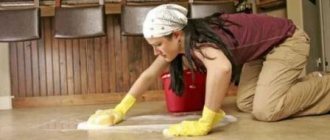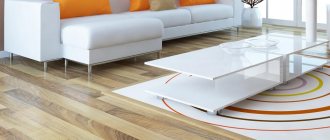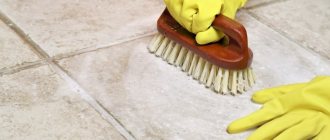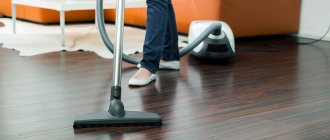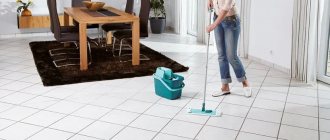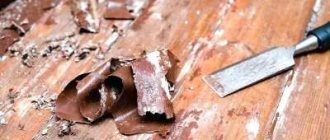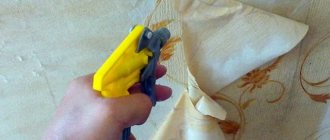Floors made of tiles and porcelain stoneware “please the eye” only when perfectly clean
Any contamination - be it shoe marks, frozen splashes of grease or limescale - gives the coating a sloppy appearance and spoils the overall impression of the interior.
In this article we will tell you how to clean ceramic tile and porcelain stoneware floors quickly and without streaks. We will recommend effective cleaning products for floor tiles in the bathroom, kitchen and hallway. We'll tell you how and how to clean tile floors from household and construction contaminants.
Porcelain tile cleaning products
The Cleanfix company offers effective professional products for washing and cleaning porcelain tiles.
Ceramic granite obtained from slip is a material characterized by high hardness and resistance to chemicals. The material is resistant to mechanical stress, tolerates temperature changes well and is resistant to moisture, which allows it to be widely used for both interior and facade decoration. However, it also has its conditional disadvantages. The “weak link” of porcelain stoneware is its porous structure. In this regard, it is quite vulnerable, since with irregular and unprofessional care, the risks that the micropores of the surface will become clogged with dirt and grease are quite high. The products we offer for cleaning porcelain tiles, if used correctly and continuously, will reduce such risks to zero, and ensure perfect cleanliness for polished or unpolished porcelain tile flooring.
How to clean porcelain tiles?
There are few finishers who, after completing all work on site, would not have to eliminate side effects of their activities. No matter how careful the craftsmen are, splashes of primer, putty, paint and other finishing materials still end up on porcelain stoneware floors and walls and leave stains on them. How to clean up soiled porcelain tile cladding as quickly and efficiently as possible, so as not to “disgrace yourself” in front of the customer?
Before answering this question, it is necessary to remember what materials can contaminate porcelain stoneware during the finishing process. In addition to the already mentioned primers, putties and paints, these can be tile or other adhesives, polyurethane foam, as well as cement- or epoxy-based grouting compounds and, in a rare case these days, whitewash.
Actions of master finishers
Ideally, stains and splashes from the listed contaminants should be removed immediately after they appear on porcelain tiles. In this case, as a rule, it is enough to use a woven (or non-woven) napkin or sponge soaked in water. The exception is, perhaps, polyurethane foam, polyurethane adhesives and epoxy-based grout - here you cannot do without a solvent.
If you manage to eliminate fresh contamination, then in the future the final cleaning of the surfaces finished with porcelain stoneware will not be difficult. First you need to remove large fractions, then wipe the remaining dirt with a cloth and soapy water. This simple procedure must be repeated several times, periodically washing the napkin in running water. At the final stage, carefully wipe the tiles with a dry cloth.
It gets worse where you have to remove dried and old stains. In such a situation, you will have to use mechanical and chemical methods. The greatest difficulties are caused by the removal of old stains from porcelain tiles that have a polished or, conversely, textured, for example, lapped surface. Using mechanical action, you can remove lumps of cement glue, putty, polyurethane foam, and grout. A knife, plastic grater, or spatula are suitable for this. In this case, you need to act extremely carefully so as not to damage the surface of the tile. Porcelain tiles with polished and glazed surfaces are especially sensitive to mechanical damage. It is strictly not recommended to use abrasive products for mechanical cleaning - metal brushes, sandpaper, etc.
The chemical method of removing old stains mostly involves the use of chemically active substances selected based on the type of contamination. It is best to use cleaners produced by the world's leading manufacturers of construction chemicals. Cleaning compositions designed to remove a wide variety of stains from the surface of porcelain stoneware are produced by LITOKOL (Italy), MELLERUD (Germany), BELLINZONI (Italy), ATLAS CONCORDE (Italy), etc.
If for some reason you don’t have branded cleaners at hand, you will have to use folk remedies.
To combat dried or old stains, it is first recommended to make a compress from a napkin moistened with a cleaner.
In the case of polymer glue, an acetone-containing solvent or acetic acid can be used as a cleaner. Stains from cement and cement-based grout can also be removed with vinegar or another organic acid. At the same time, you need to ensure that acid or acetone does not get into the seam filled with grout, especially if it is colored. By the way, the world's major manufacturers of construction chemicals produce cleaners that, if they get into a seam, will not spoil the grout. In particular, the LITOKOL company produces such a composition called Litoclean Plus.
It is not recommended to use inorganic acids for dry cleaning - sulfuric, hydrochloric, etc., since all actions with them require increased safety measures.
To remove epoxy resin or compositions based on it, you will need a special solvent, for example, Litostrip (LITOKOL). To clean paint stains, you should choose a solvent that acts on its binder. Splashes and smudges of water-based paint are removed with water.
Whitewash stains are removed in several steps. First, the stained surface is washed several times with water. It is important that the water is changed all the time. Particularly contaminated areas are wiped with a sponge or cloth moistened with household detergents. Then the surface is washed again with water.
Polished tiles can be easily cleaned of whitish stains with a window cleaner containing alcohol.
So, the cladding is sparkling clean, the customer is happy, what next?
Note to home owners
Having received a brand new interior, every homeowner wants to keep it in its original form for as long as possible. Porcelain stoneware perfectly matches this aspiration due to the combination of unique operational properties inherent only to it. For example, porcelain stoneware from the Russian company ESTIMA Ceramica has a hardness of 7–8 on the Mohs scale. For comparison: diamond and corundum have 10 and 9 points, respectively.
The significant hardness of porcelain stoneware indicates a very high abrasion resistance of this material, and, accordingly, excellent wear resistance.
It is very important that porcelain stoneware has extremely low absorbency. In particular, the water absorption rate of ESTIMA Ceramica porcelain tiles is less than 0.5%. This means that porcelain stoneware is extremely insensitive to household pollution. This property is achieved, on the one hand, due to the density of the shard itself, on the other hand, due to the fact that during the production process the surface of the porcelain stoneware is treated with granils - special compounds that prevent wetting and the absorption of contaminants. Porcelain stoneware undergoes this procedure at the enterprises of ESTIMA Ceramica. In addition, each batch of porcelain tiles is tested in laboratory conditions for resistance to stains. That is why daily hygienic maintenance of porcelain tile cladding does not require serious effort - just wipe the surface with a damp cloth.
Still, porcelain tiles can accumulate dirt on the surface. This happens when the floor tiles are worn out during intensive use over several decades. To prevent the appearance of difficult-to-remove stains, it is recommended to periodically wipe the floor with protective agents containing beeswax or artificial wax, as well as special polyurethane-based emulsions. After this treatment, all dirt is removed using ordinary water. Protective compounds that prevent the accumulation of dirt are produced by companies that produce cleaners for ceramics, porcelain tiles and natural stone.
In conclusion, a few more tips. To make the surface lined with porcelain stoneware shine, it is recommended to add lemon juice or essential oils contained in lemon peels to the washing water. The same effect can be achieved by pouring a little acetic acid into the water.
It is better to clean porcelain tiles with a textured surface using a steam generator or a steam vacuum cleaner. After removing dirt, the surface of the tile should be wiped with a dry cloth.
As you can see, the timely removal of contaminants from porcelain stoneware surfaces and their preventive maintenance during operation is not difficult and significantly makes life easier for decorators and interior owners, and also, importantly, does not require significant effort and large financial costs.
Cleaning products for porcelain tiles
The choice of a specific product for cleaning porcelain stoneware is, first of all, determined by the method of treating the surface of this material. However, the result of the installation work itself is important - their consequence is often all kinds of traces from glue and grouting materials, as well as cement. All these almost inevitable traces of repair and finishing can be quickly removed using porcelain tile cleaning products produced on the basis of inorganic acids. Depending on the specifics of the task, they can be used in concentrated form or as working solutions - porcelain stoneware perfectly withstands the effects of acids. Removal of cement, glue, and “excess” grout can be done manually or by machine. After washing with an appropriate solution, liquid dirt can be removed manually with a squeegee, mop, or machine - using a water vacuum cleaner. An example of such a cleaning agent is presented in our catalog - this is a highly concentrated acidic cleaning agent for porcelain tiles CERACID.
Types of contamination after repair
Fresh dirt during repairs can be easily removed with a wet cloth.
During repairs, ceramic tiles on the floor may become dirty:
- sealant;
- primer mixture;
- adhesive composition;
- grout;
- paint;
- putty;
- cement.
The listed substances can be easily wiped off from porcelain tiles with a wet cloth if this is done immediately as soon as the composition hits the tile.
When removing old stains, the process becomes much more complicated, because simple water with the addition of detergents cannot remove all types of contaminants. In such cases, you need to use special chemical compounds that can remove any dirt.
Methods for cleaning old contaminants
To remove old stains, you can resort to using a mechanical or chemical method:
- Mechanical – involves combating dirt using a knife, sandpaper or a construction float. When choosing this method, we must not forget about caution, because there is a possibility of damage to the tile covering. This cleaning method is used to remove lumps of cement, putty residues, and polyurethane foam.
- Chemical – involves soaking stains with solutions selected according to the type of contamination.
In the second case, you can use ordinary soap solution or industrial specialized products.
Cleaning products for polished porcelain tiles
Polishing provides porcelain stoneware with a magnificent aesthetic appearance - the floor covering, processed to a shine, has a noble, “expensive” and attractive appearance. However, this polished surface also has a downside - such porcelain tiles are more vulnerable to moisture. The fact is that when polishing, the molecular structure of the material is disrupted, micropores appear into which liquid dirt can easily get. But this problem can also be solved.
Alkaline porcelain tile cleaners reliably protect this material, polished to a shine. The alkaline composition copes well with dirt in micropores, destroying it “completely”, in addition, it preserves the ability of this porous material to “breathe”, which has a beneficial effect on the condition of the floor covering, the durability of the material, and its appearance. Washing the stone can also be done either manually (as part of regular cleaning) or by machine (usually during general cleaning).
We clean porcelain tiles from stains of various natures
When using this type of surface, various unpleasant situations can occur, as a result of which stains may appear on the floor tiles. For kitchen floors, as well as floor surfaces in catering establishments, these stains are often associated with food dyes, as well as various liquids, including first courses and drinks, getting onto the floor. If the stains are fresh, you can wash them by dissolving a small amount of baking soda in water, but for old, dried stains you will need an alkaline-based detergent or cleaner for porcelain tiles.
How to clean porcelain tiles if they have been exposed to construction paints, silicone or superglue, sticky compounds, stamp paint, ink, varnishes and paints used in nail care? In this case, the usual means, the use of which involves the daily care of porcelain tiles, will not be enough. To remove such stains, solvents such as gasoline or acetone are used.
If children are “pleased” with paintings on porcelain tiles drawn with a felt-tip pen, then they will have to be washed off with acid-based products, but it is worth remembering that getting acid on the tile joints can destroy the entire structure of the epoxy composition.
In order to enjoy the beauty and practicality of porcelain stoneware for a long period of time, you should follow simple rules for the systematic care of this finishing material and avoid severe contamination of the tiles.
Cleaning agents for untreated porcelain tiles
Unpolished porcelain tiles are also vulnerable to contamination because they have a rough surface as a result of rough processing. However, there are also tools for it that can be used to perform deep and effective cleaning. These concentrated alkaline cleaners are also presented in our catalog, for example CERA-CLEAN. Depending on the concentration, it can be used for daily or periodic machine cleaning, and also, if necessary, for intensive cleaning. In addition, in concentrated form, the product is perfect for removing stains.
You can check the prices for cleaning and washing porcelain tile products, ask other questions you are interested in, and also place an order by phone;.
How to clean porcelain tiles
Cleaning porcelain tiles depends on the degree of contamination.
If during the repair work the dirt was removed from the tiles immediately, then upon completion of the repair it will be enough to wash the tiles to remove any resulting dust. To do this you need:
- Clean the surface from large fractions of debris and other contaminants.
- The remaining dust on porcelain tiles is cleaned with a damp cloth soaked in any soap solution.
- To prevent streaks, the fabric used must be rinsed well in water.
- After cleaning the floor, it is recommended to rub the tiles with a dry cloth.
Important! Window sprays containing alcohol will help avoid streaks on polished tiles.
How to wash tiles - quickly, effectively and without streaks.
Cleaning tile joints
Reading time: 1 minute To be as good as new! Over time, a brand new shiny tile becomes cloudy and covered with various types of dirt or grease.
There is only one reason for this - unfortunately, you don’t know how to wash tiles.
The dirt remains due to the following: Dirty sponge, rag, napkin.
You haven’t washed your “tool” well enough; grease has accumulated on it or pieces of dirt are stuck. Not completely rinsed off.
Now to practice: how to clean ceramic tile and porcelain stoneware floors
And finally, let's look at how to clean a tiled floor with a mop with a flat, movable cleaning platform.
Step 1 : Vacuum or sweep the floor to remove sand and other loose debris.
Step 2: Prepare a cleaning solution. Add tile cleaner to warm or hot water. To reduce the level of concentration of the product in the solution, reduce its “dosage”, and to increase it, increase it (to remove persistent contaminants).
Step 3. Take 2 microfiber mops - one for wet cleaning, and the other for finishing the floor. Soak one mop in the solution, wring it out (slightly damp) and place it on the mop's washing platform.
Step 4: Mop the tile floor by moving the platform from side to side in a figure eight pattern. One edge of the platform should always be in front, collecting and moving dirt from the clean area to the not yet washed area.
Step 5: Treat stubborn stains with an acid/alkaline solution. After 3-5 minutes, scrub the stains with a brush. Remove the product with a microfiber cloth.
Step 6: Fill the bucket with warm or hot water. Soak a mop that has been rinsed under the tap in it. Place the mop on the mop and mop the floor a second time, removing the cleaning solution.
Step 7. Remove the wet mop from the platform and put on a dry one. Wipe the floor to remove any residual moisture.
Source
How to wash tiles without streaks?
Every housewife is familiar with the problem of soiled tiles.
If you stubbornly wash your tiles, but there are still stains on them, and you don’t know how to deal with them, then read on.
In this article you will learn how to clean a tile floor without streaks.
To carry out high-quality cleaning, you need to know the causes of certain defects. The most pressing problem is the problem of the formation of stains on the surface after it is cleaned. Unwashed dirt. This is a fairly common problem.
When cleaning excessively dirty tiles, dirt particles spread over the entire surface and complete cleaning of the tile becomes problematic; Insufficiently clean water. When cleaning the tiles, it is worth changing the water several times, because a small amount of dirt may remain in it; Hard water.
Source
Cool ways to wash tiles without streaks
→ → Floor tiles are one of the most common coverings in residential and non-residential premises.
But it will last the period guaranteed by the manufacturer only if all care recommendations are followed. You need to clean stains, taking into account the reason for their occurrence. The most common:
- dirty water. You need to change it regularly, otherwise, when the floors dry, dirty streaks will remain on them and you will have to completely wash everything.
- fat. First you need to remove the stain, and then wash the entire floor so as not to leave greasy marks all over the surface;
- A cleanser that is not completely rinsed off. This is why many people make do with plain water;
- dirty rag. You need to rinse it regularly and very thoroughly;
- hard water. It leaves behind divorces;
Cleaning begins with dry collection of waste. To do this, you can use a vacuum cleaner, brush or broom.
Particular attention should be paid to the seams.
